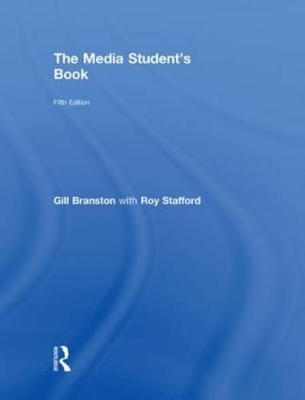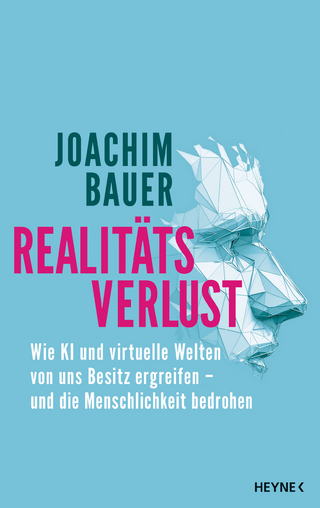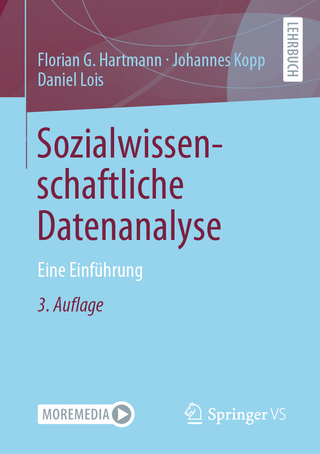
The Media Student's Book
Routledge (Verlag)
978-0-415-55841-9 (ISBN)
- Titel ist leider vergriffen;
keine Neuauflage - Artikel merken
The Media Student's Book is a comprehensive introduction for students of media studies. It covers all the key topics and provides a detailed, lively and accessible guide to concepts and debates.
Now in its fifth edition, this bestselling textbook has been thoroughly revised, re-ordered and updated, with many very recent examples and expanded coverage of the most important issues currently facing media studies. It is structured in three main parts, addressing key concepts, debates, and research skills, methods and resources. Individual chapters include:
approaching media texts
narrative
genres and other classifications
representations
globalisation
ideologies and discourses
the business of media
new media in a new world?
the future of television
regulation now
debating advertising, branding and celebrity
news and its futures
documentary and `reality’ debates
from `audience’ to `users’
research: skills and methods.
Each chapter includes a range of examples to work with, sometimes as short case studies. They are also supported by separate, longer case studies which include:
Slumdog Millionaire
online access for film and music
CSI and detective fictions
Let the Right One In and The Orphanage
PBS, BBC and HBO
images of migration
The Age of Stupid and climate change politics.
The authors are experienced in writing, researching and teaching across different levels of undergraduate study, with an awareness of the needs of students. The book is specially designed to be easy and stimulating to use, with:
a Companion Website with popular chapters from previous editions, extra case studies and further resources for teaching and learning, at: www.mediastudentsbook.com
margin terms, definitions, photos, references (and even jokes), allied to a comprehensive glossary
follow-up activities in `Explore’ boxes
suggestions for further reading and online research
references and examples from a rich range of media and media forms, including advertising, cinema, games, the internet, magazines, newspapers, photography, radio, and television.
Gill Branston is Honorary Senior Lecturer at the School of Journalism, Media and Cultural Studies at Cardiff University. Roy Stafford is a freelance lecturer, writer and examiner in media education and training.
List of Figures
Acknowledgments
Introduction
Section 1: Key concepts
1 Approaching media texts
Introduction
Semiotic approaches
Structuralism, difference(s), and oppositions
Denotation and connotation
The social nature of signs
Debates
Content analysis
Conclusion
Case study: Visual and aural signs
Analysing a poster, and notes on two photos
Voices and sound signifiers
Audio-visual moving images
Content analysis
2 Narratives
General theories of narrative
Narration, story and plot
Narratives in different media
Long running and `single’ narratives
`New media’ and narrative debates
Conclusion
References and further reading
Case study: CSI: Miami and Crime fiction
The classification `crime fiction’
Plot/story
Applying Todorov
Applying Propp
Applying Barthes
Applying Lévi-Strauss
Narratives, institutions, ideologies
References and further reading
3 Genres and classification
Classifying films: Thelma and Louise (US 1991)
Repetition and difference
Repertoires of elements
Case study: Formats and genres
Status and genres 1: `escapism’ and verisimilitude
Status and genres 2: the cultural context
Conclusion
References and further reading
Case study: Horror as popular art The Orphanage and Let the Right One In
The child in the horror film
Global and local audiences
Style and the Gothic: different repertoires
Authorship and promotion
Distribution patterns
4 Representations
`Representation’ now
Stereotyping and `scripts’
Case study 1: US plantation stereotyping
Scripts and performances
Case study 2: Representations and gender
Stages of change, and `positive/negative’ debates
Realisms and representations
Comedy and questions of representation
Historical and institutional processes
Conclusion
Reference and further reading
Case study: Images of migration
Introduction
Discourses and stereotypes of `migration’ and other kinds of travel
News media
The `grain of truth’ in stereotypes?
Varieties of media representations
References
5 Globalisation
Your experiences of globalisation
Global histories
Approaches to globalised media
Global-local flows
Global futures?
Conclusion
References and further reading
Case study: Slumdog Millionaire: global film?
The background to a global hit
The production of the film
Distribution
The Bollywood connection
Controversies in reception
After the Oscar ceremonies . . .
6 Ideologies and discourses
Introduction
`Ideology’ and its histories: Marxist approaches
The persistence of class and its (in)visibility
Post-Marxism and critical pluralism
Discoures
Lived cultures
Conclusion?
References and further reading
Case study: The Age of Stupid (UK 2009) and Climate Change Politics
Introduction
Context: images and discourses
The term `propaganda’
Textual approaches to the film
`Cinema’ and its `everyday practices’
Conclusion
7 Media as Business
Studying business organisations
Ownership and control
The experience of conglomerates
New players in India and China
Public or private funding?
Public or private in filmed entertainment
The new digital environment
Business models
Different perspectives
Conclusion
References and further reading
Case study: Music and movies – digital and available
The challenge of copying
Piracy
Changing models in the film industry
Section 2 : Debates
8 `New media’ in a `new world’?
Introduction
`Newness’ and histories
Academic approaches
Openness, collaboration and `users’
`The long tail’
Digital copies and the `enclosure’ of information
New media, old metaphors
`New media’, vanishing resources
Conclusion
References and further reading
9 The future of television
Introduction
Ownership and control in the television industry
Paying for television
Business models for television broadcasting
Public service broadcasting
Network television
Subscription
10 Regulation now
Introduction
Politics and media economics
Regulation and `freedom’
Historical background
Changes in the orthodoxy of economic policies and new models
Deregulation, liberalisation and media institutions
The contemporary regulatory environment
A `free market’ for classification, censorship and sex and violence?
The public gets the media it deserves?
`Free choices’ and free speech?
Conclusion
References and further reading
11 Debating advertising, branding and celebrity
Introduction
Advertising, marketing and branding
Debates
Histories
Hollywood and branding
Hollywood: the brand(s)
Case study: `Brangelina’
Citizenship and consumption
References and further reading
12 News and its futures
Introduction
The importance of news, and views of `the public’
The construction of `news’
`Impartiality’ and accuracy
`News values’
Debates on the influence of news
Futures: `new’ news?
Conclusion
References and further reading
13 Documentary and `reality’ debates
Recent issues in documentary
Documentary and assumptions about `realism’ and truth
`Direct Cinema’
Performance and documentary
Ethics and documentary
Recent hybrids 1: `pranksters’
Recent hybrids 2: `reality TV’
Recent hybrids 3: forms of `drama documentary’
Conclusion
References and further reading
14 From `audience’ to `users’
Introduction
Academic representations of audiences
The effects model
The uses and gratifications model
From `effects’ to `influence’: factual forms
`Cultural’ approaches
Re-mediating audiences
Conclusion
References and further reading
Section 3 : Research methods and reference
15 Research: skills and methods
Introduction
Basics
Using the internet, and print forms
Fear of `theory’
Methods
Qualitative and quantitative
Textual approaches
Samples
Focus groups
`Ethnographic’ methods
Footnote : Wikipedia
References and further reading
Glossary
Index
| Erscheint lt. Verlag | 17.6.2010 |
|---|---|
| Zusatzinfo | 192 Halftones, color |
| Verlagsort | London |
| Sprache | englisch |
| Maße | 189 x 246 mm |
| Gewicht | 1200 g |
| Themenwelt | Sozialwissenschaften ► Kommunikation / Medien ► Medienwissenschaft |
| ISBN-10 | 0-415-55841-7 / 0415558417 |
| ISBN-13 | 978-0-415-55841-9 / 9780415558419 |
| Zustand | Neuware |
| Haben Sie eine Frage zum Produkt? |
aus dem Bereich


